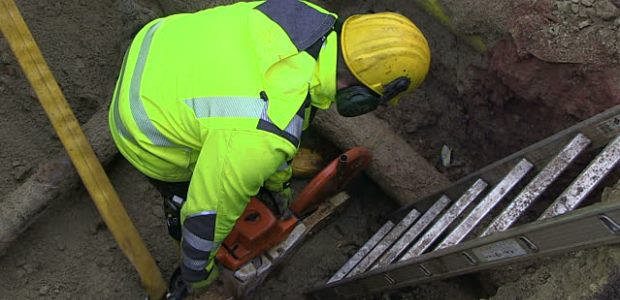
The SROI Solution
Social Return on Investment analysis can help with our country's crumbling water infrastructure.
The United States is currently in the midst of a water infrastructure crisis. Much of our water infrastructure is over 100 years old, and the entire system is need of a costly overhaul. It's estimated that replacing all of the obsolete or broken aspects of our water infrastructure would run, at the bare minimum, roughly $1 trillion. A successful infrastructural overhaul will not only limit the amount of leaks or broken water pipes in the U.S., but it should also improve the quality of life for all community members affected by the improvement process. To create a more sustainable and comprehensive strategy, planners should look beyond a simple cost-benefit analysis when preparing an upgrade strategy. Instead, they should turn to a social return on investment (SROI) analysis, which is a participatory process for understanding, measuring, and reporting on the social, environmental, and economic value (i.e., the triple bottom line) created by an organization, program, or policy.
An SROI analysis is like an extension of a cost-benefit analysis, except that it explicitly requires the participation of key stakeholders in the analysis process. This is particularly beneficial in the water infrastructure context given the various city agencies and stakeholders who are involved. By performing an SROI analysis, planners can ensure that individual communities not only receive the best infrastructural upgrades possible, but that they also get the best long-term value out of their investment, and that all key stakeholders involved have a say in choosing a strategy that works best for their respective goals.
Poor Water Infrastructure
The U.S. water infrastructure is quite extensive. More than 156,000 public water systems and more than 700,000 miles of piping bring drinking water to homes throughout the nation, and although the infrastructure is aging, the quality of water delivered is generally high—instances of waterborne illnesses in the United States are uncommon. However, the water systems and piping are outdated and overworked, and much of the infrastructure needs to be replaced.
It's estimated that our infrastructure loses 1.7 trillion gallons of water a year to leaks, broken pipes, and other faulty water systems. There are more than 240,000 water main breaks across the year nationally, and it's estimated that these leaks and breaks cost roughly $2.6 billion annually. Additionally, there is a dire need now more than ever before for advanced water treatment systems as water shortages become more prevalent. Though our water quality is generally high, our method of water delivery is faulty, which is why the American Society of Civil Engineers gave the U.S. water infrastructure a D+ grade on their 2013 American Infrastructure Report Card.
When water systems aren't properly maintained, health crises can arise. For instance, in order to save money, Flint, Mich., switched its water supply two years ago from nearby Lake Huron to the Flint River. The river features high iron levels, which caused the water to be extremely corrosive. The city failed to add a relatively inexpensive anti-corrosive agent to the water sourced, and because many of the service lines in Flint are made from lead, the water began to eat away at the piping, causing lead to leach into the drinking supply. Failing to update and maintain the nation's water infrastructure not only leads to broken pipes and costly leaks, but it can also spur devastating health crises like the one in Flint. That's why an overhaul of the national water system is of the utmost importance.
Why SROI Analysis is More Effective
SROI analysis measures not only financial impacts—such as overall cost—but it also takes into account the social, economic, and environmental impacts. In other words, SROI explores not only how much a given project might cost, but it also examines how that project might impact stakeholders in a broad but tangible sense over the long term. For example, a project's SROI value can be determined by analyzing how much value (socially, environmentally, and economically) a project delivers to a community for every dollar invested. So, if a project has an SROI of 3:1, that means that for every $1 invested, the program delivers $3 in value. A water infrastructure project with high SROI value, for instance, won't just be affordable in a logistical sense, but it will deliver broader value in the form of generating positive social and health benefits, such as high-quality drinking water, which would reduce waterborne disease and reduce lost time/income at work or absenteeism in school.
Looking at the broader, multi-faceted impact of a particular strategy allows it to be more effective than simply focusing on one aspect. Additionally, because multiple stakeholders are involved, this framework helps to boost overall accountability, communication, and participation. While stakeholders will have varying values and end goals, SROI helps to merge those goals into one and creates a common language across stakeholders.
In short, addressing our national water infrastructure crisis is a top priority. However, remedying the issue properly will require more than monetary investment: planners should turn to SROI to create options that address the best possible social, economic, and environmental return on investment. While SROI analysis isn't a perfect model, it does help to encourage accountability, transparency, and sustainability in decision-making. It also helps to involve stakeholders and community members who may not typically have a voice in such processes, but who can provide invaluable input and assessments, just as local doctors and community organizers were some of the first people to recognize the water issues in Flint.
Shubha Kumar, Ph.D., MPH, is Assistant Professor of Clinical Preventive Medicine and Director of the Online Master of Public Health Program at the Keck School of Medicine, University of Southern California.